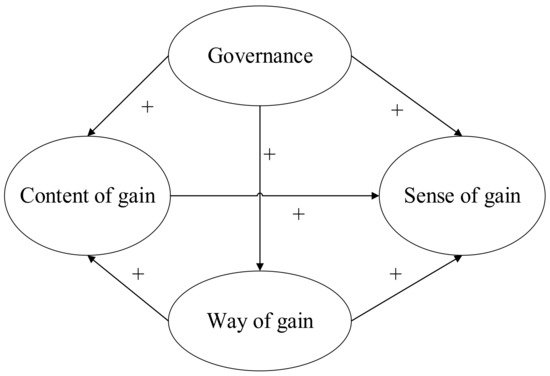You're using an outdated browser. Please upgrade to a modern browser for the best experience.
Please note this is a comparison between Version 1 by LEI ZHU and Version 2 by Vivi Li.
Rural infrastructure is not only the foundation for the development of various rural undertakings but also an integral part of the rural economic system. Its construction and operation are closely related to farmers’ quality of life. However, owing to the urban–rural dual structure in many countries in the world, there is still a big gap between the level of rural infrastructure and that of cities, which affects the interests of farmers and restricts the sustainable development of rural areas. The sense of gain can reveal shortcomings in the rural infrastructure from the perspective of farmers, helping to suggest rapid and accurate improvements according to the farmers’ feelings.
- rural infrastructure
- sense of gain
- structural equation model
- fuzzy comprehensive evaluation
1. Introduction
Rural infrastructure is not only the foundation for the development of various rural undertakings but also an integral part of the rural economic system [1]. Its construction and operation are closely related to farmers’ quality of life. However, owing to the urban–rural dual structure in many countries in the world, there is still a big gap between the level of rural infrastructure and that of cities, which affects the interests of farmers and restricts the sustainable development of rural areas [2][3][2,3]. Many related policies and initiatives have been proposed to narrow this gap. Taking China as an example, a new rural policy that proposes continuous improvement of the conditions of rural infrastructure for sustainable development was promulgated in 2018. It is worth noting that this policy takes the “sense of gain” as one of the important evaluation indicators. The sense of gain can reveal shortcomings in the rural infrastructure from the perspective of farmers, helping to suggest rapid and accurate improvements according to the farmers’ feelings.
Through an in-depth literature review, rwesearchers found that many previous studies used satisfaction rather than sense of gain to evaluate rural infrastructure. Based on clear expectations, satisfaction can measure the gap between experience and expectations [4]. The American Customer Satisfaction Index and other statistical methods have been widely used to evaluate the condition of rural infrastructure and the satisfaction of farmers. By making some adjustments to the American Customer Satisfaction Index, Chen et al. formed an index system and evaluation model for farmers’ satisfaction with China’s rural public infrastructure and used the Interpretive Structural Model (ISM) to validate it [5]. Li et al. (2020) analyzed a satisfaction model on the internal mechanism, which reveals the relationship between expectations, perceived quality, perceived value, and satisfaction by using Structural Equation Modeling (SEM) [6].
However, the fact is that farmers do not have a clear expectation of use of the rural infrastructure. They make subjective evaluations based on their experience of use. Considering that gain can express people’s unclear expectations, the sense of gain is suitable for measuring the subjective feeling after the experience of use [7]. Several previous research studies have used the sense of gain to evaluate public services and public utilities. Gu et al. (2020) built an evaluation index system for the sense of gain from the perspectives of material and spirit and used the sense of deprivation as the opposite to supplement the evaluation of the sense of gain [7]. Wang et al. (2020) summarized the influencing factors of the sense of gain from four aspects, namely, objective factors, subjective factors, institutional factors, and practical participation factors [8]. Sun (2020) and Feng et al. (2021) carried out evaluations of the public health service [9] and the public education service [10] through the sense of gain, respectively. However, there is currently very little published research on the evaluation of the rural infrastructure from the perspective of the sense of gain.
Considering the actual needs and the current research status, there is an essential need to explore the influencing factors, influencing mechanisms, and realistic levels of farmers’ sense of gain in the provision of rural infrastructure from the subjective perspective of farmers. Therefore, this enstrudy aimed to build a comprehensive evaluation model of the farmers’ sense of gain in the construction and operation of rural infrastructure. The objectives of this study are: (1) to propose hypotheses for the influence mechanism of the farmers’ sense of gain from four perspectives, which are the social governance system, the content of gain, the way of gain, and the sense of gain through a theoretical analysis; (2) to develop an evaluation index system for the constructs in the influence mechanism through a comprehensive literature review and rural field investigations; (3) to conduct a questionnaire survey and field investigations; (4) to use Structural Equation Modeling (SEM) and AMOS software to verify the proposed hypotheses; (5) to develop a fuzzy comprehensive evaluation model of the farmers’ sense of gain in the provision of rural infrastructure. The research results could contribute to the body of knowledge of the evaluation of the farmers’ sense of gain and the theories of sustainable development of rural areas. Moreover, the proposed model can help to efficiently discover deficiencies in the provision of rural infrastructure and provide theoretical support for putting forward targeted improvement strategies for the sustainable development of rural infrastructure.
2. Influence Mechanism of the Sense of Gain

Figure 1.
Conceptual framework of the influencing mechanism of the farmers’ sense of gain.
 Encyclopedia
Encyclopedia